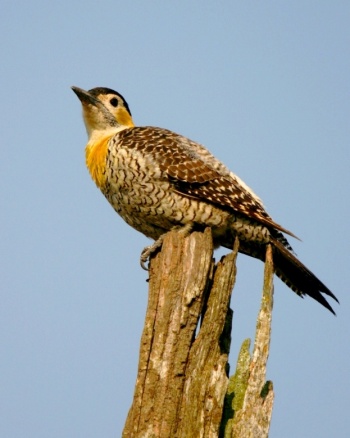- Colaptes campestris
The southern race campestroides is commonly referred to as the Field Flicker.
Identification
At a first sight, can be mistaken with the Green-barred Woodpecker (Colaptes melanochloros), but after a better look they are easily separated by many characteristics.
This species has dark upperparts, including crown and tail, and paler belly. Breast, nape and auriculars are yellow, while the throat color varies according to the subspecies (see Taxonomy). Males of this species, as well as in many other Colaptes species, have red malar regions. This characteristic is not present in females.
Distribution
It is found in eastern and central Brazil, northern and eastern Bolivia, Paraguay (except far south-west), Uruguay, and northeastern and eastern Argentina.
Taxonomy
Two races are recognised:
- C. c. campestris occurs in northeastern and central Brazil, northern and eastern Bolivia and northern Paraguay. It has a black throat, which is the the best way to tell the subspecies apart.
- C. c. campestroides, the Field Flicker, occurs in southern Brazil, southern Paraguay, Uruguay, and northeastern and eastern Argentina. This race shows a white throat.
The two races are sometimes considered different species.
Habitat
It is found in cerrados (brushy areas), caatingas (dry woodland and scrub), savanna, grassland, pampas, plantantions, pastures, parks or even cities, which are mostly open areas. It is a species that takes advantage of deforestation where termites and ants, its favorite prey, invade low-grade and overgrazed pastures. Generally common.
Behaviour
Social and largely terrestrial. This species is commonly seen leaping on the ground in groups of about 8 or 10 individuals, searching for anthills. Nest is typically in tree or dead stump, but sometimes in termite mound or earth bank.





